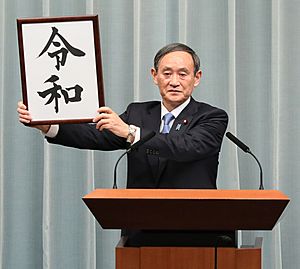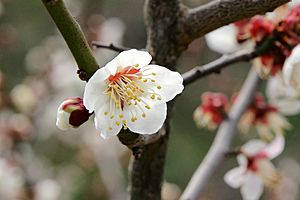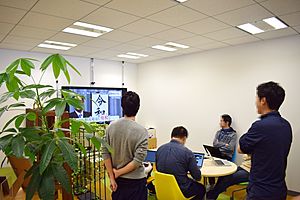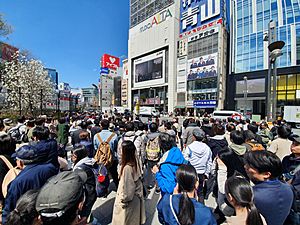Reiwa era facts for kids
令和
| 1 May 2019 – present | |

Emperor Naruhito of the Reiwa era (2019)
|
|
| Preceded by | Heisei |
|---|---|
| Including |
Major events
COVID-19 pandemic in Japan (2020–2023)
2020 Summer Olympics (2021) Assassination of Shinzo Abe (8 July 2022) Saikazaki bombing (15 April 2023) |
| Monarch | Naruhito |
 |
|---|
|

The Reiwa (Reiwa (令和, pronounced [ɾeːwa])) is the current official calendar era in Japan. It started on May 1, 2019. This was the day Emperor Naruhito became the 126th Emperor of Japan.
The day before, his father, Emperor Akihito, stepped down from the throne. This ended the previous era, called the Heisei era. So, the year 2019 was partly Heisei 31 (until April 30) and partly Reiwa 1 (from May 1). The Japanese government has explained that "Reiwa" means "beautiful harmony."
Contents
What is the Reiwa Era?
Announcing the Name
The Japanese government announced the new era name, Reiwa, on April 1, 2019. This was done during a live TV press conference. Chief Cabinet Secretary Yoshihide Suga showed the special Japanese characters (called kanji) for the name on a board.
The Prime Minister at the time, Shinzō Abe, said that "Reiwa" means "a culture being born and nurtured by people coming together beautifully."
How the Name Was Chosen
A special group of nine experts helped choose the new era name. This group included scientists, writers, and judges. The government then picked the final name from a list they provided.
After the announcement, the government shared some other names that were considered. However, "Reiwa" was chosen because of its special meaning and origin.
Where the Name Comes From

The characters for "Reiwa" come from a very old Japanese poetry book called the Man'yōshū. This book was written in the 8th century. The name comes from a poem about enjoying plum blossoms.
The original poem describes:
English translation:
It was in new spring, in a fair (rei) month,
When the air was clear and the wind a gentle (wa) breeze.
Plum flowers blossomed a beauty's charming white
And the fragrance of the orchids was their sweet perfume.
The Japanese Foreign Ministry explained that "Reiwa" means "beautiful harmony." They wanted to make sure people understood that the character "Rei" here means "fair" or "beautiful," not "command" or "order," which are other common meanings of the character.
Why Reiwa is Special
"Reiwa" is the first Japanese era name that uses characters from Japanese literature. Before this, all era names came from old Chinese literature.
Experts say that the character "Rei" in this context means a good, positive energy, like the plum blossoms carried by the wind. The character "Wa" means peace and calmness.
The name "Reiwa" is the 248th era name in Japan's history. While the "wa" character has been used many times before, the "rei" character had never been used in an era name until now.
How the Reiwa Era Works
Money and Technology
New Japanese coins with the "Reiwa" era name started to be released in October 2019. The Japan Mint made sure that the most used coins, like the 100-yen and 500-yen coins, were available first.
Also, technology companies like Microsoft updated their systems (like Windows 10) to support the new era name. This helps computers correctly show dates in the Japanese calendar. A special symbol for "Reiwa" was even added to the Unicode system, which helps computers display text from different languages.
Important Events in the Reiwa Era
Since the Reiwa era began, several important events have happened in Japan and the world.
- In November 2019, Shinzo Abe became the longest-serving prime minister of Japan. He resigned in September 2020 due to health reasons. Yoshihide Suga then became prime minister.
- Starting in early 2020, Japan, like many other countries, faced the COVID-19 pandemic.
- In June 2020, "Fugaku," a supercomputer co-developed by RIKEN and Fujitsu, was named the most powerful supercomputer in the world.
- The 2020 Tokyo Olympics were held in the summer of 2021, a year later than planned due to the pandemic.
- In September 2021, Fumio Kishida became the new prime minister of Japan.
- In March 2022, a strong earthquake near Fukushima caused damage and injuries.
- In July 2022, former Prime Minister Shinzo Abe was assassinated. This was a very rare event in Japan, which has very few gun-related deaths.
- In 2022, Japan joined other countries in putting sanctions on Russia because of its invasion of Ukraine. Japan was the first Asian country to do so.
- In December 2022, Japan announced plans to increase its defense budget. This decision was made due to growing security concerns in the region.
Converting Years
To find the Reiwa year from a Gregorian calendar year (like 2024), you just subtract 2018 from the year. For example: 2024 - 2018 = Reiwa 6.
| Reiwa | 1 | 2 | 3 | 4 | 5 |
|---|---|---|---|---|---|
| I | II | III | IV | V | |
| AD/CE | 2019 | 2020 | 2021 | 2022 | 2023 |
| MMXIX | MMXX | MMXXI | MMXXII | MMXXIII |
See also
 In Spanish: Era Reiwa para niños
In Spanish: Era Reiwa para niños
- 2019 in Japan
- 2020 in Japan
- 2021 in Japan
- 2022 in Japan
- 2023 in Japan
External links
- Reiwa
| Preceded by Heisei (平成) |
Era of Japan Reiwa (令和) 1 May 2019 – present |
Incumbent |




